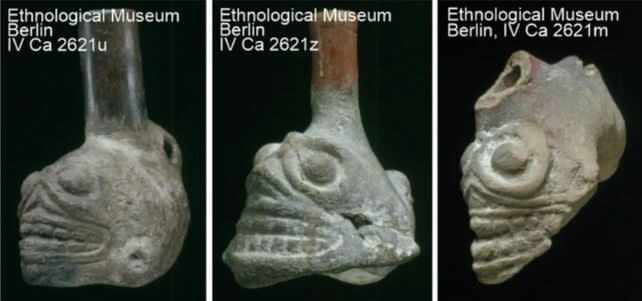Ranging from a threatening hiss to a blood-curdling scream, the sound of the Aztec death whistle is as creepy as the skull-like appearance of the instrument that produces it.
Brain scans suggest the whistle’s tones may do more than create a scary ambience. Swiss and Norwegian researchers found hearing them activates a variety of higher order centers in our brains, suggesting a complexity to the sound that can only be described as an alarming mix of the natural and the eerily unfamiliar.
It’s no wonder the Aztecs likely used them to enhance religious and sacrificial rituals.
Advertisement
Advertisement
Rumor has it the Mesoamerican civilization also used the unnerving sound to strike fear into their foes, during warfare, but that has been disputed as no whistles have been found at battle sites or in warrior graves.

University of Zurich neuroscientist Sascha Frühholz and colleagues recruited 70 European volunteers for psychoacoustic testing on their personal interpretations of a random selection of sounds which included tones made by the creepy whistles. The volunteers did not have forewarning that skull whistle sounds would be included, removing expectations prior to their ratings for each recording.
Thirty-two of the participants also had their brains scanned by fMRI while they heard the death whistles among a randomized mix of sounds from five different categories.
Most of the volunteers likened the whistle to a scream.
“We show that skull whistle sounds are predominantly perceived as aversive and scary and as having a hybrid natural-artificial origin,” the team found.
Advertisement
Advertisement
The researchers explain the strange mix between natural and artificial makes it hard for our brains to categorize, like the uncanny valley effect in sound-form. The uncanny valley occurs similarly, when our brains can’t clearly define what they’re seeing as natural or artificial.
Our brains first categorize a sensory input before using that classification to attribute value, such as likeability. But when something doesn’t fall within a clear category, the ambiguity leaves us with an unnerving sensation.
Hearing the whistle’s sound activated the low-order auditory cortical regions of the volunteer’s brains – regions which tune into aversive sounds like screams or babies crying and direct the brain to analyze the stimuli on a deeper level.
“Skull whistle sounds are… rather ambiguous in the determination of their sound origin, which intensifies higher-order brain processing,” the researchers write in their paper.
Advertisement
Advertisement
More in Science
Compared to the other tested sounds, which included some made by humans and animals, some from nature, musical sounds, and sounds made by tools, the skull whistle in particular activated the inferior frontal cortex, which deals with elaborate classification processing, and the medial frontal cortex, a region involved with associative processing.
When all sounds were compared, those made by death whistles were categorized in their own group, one close to alarm sounds such as horn, sirens and firearms as well as near human noises of fear, pain, anger and sad voices.

Human sacrifice with original skull whistle (enlarged in red box) as discovered 1987–89 at the Ehecatl-Quetzalcoatl temple in Mexico City. (Salvador Guillien Arroyo/Proyecto Tlatelolco 1987–2006/INAH Mexico)
Many versions of these whistles have been found in graves that date back to between 1250 to 1521 CE. Some of them were associated with ritual burials. Given this, and their results, Frühholz and team suspect the whistles may have been designed to symbolize Ehecatl, the Aztec God of Wind.
“[Ehecatl] traveled to the underworld to obtain the bones of previous world ages to create humankind,” the researchers explain.
Advertisement
Advertisement
Alternatively, the spine-chilling skull whistles may have represented the sharp winds that pierce Mictlan, the Aztec’s underworld.
“Given both the aversive/scary and associative/symbolic sound nature as well as currently known excavation locations at ritual burial sites with human sacrifices, usage in ritual contexts seems very likely, especially in sacrificial rites and ceremonies related to the dead,” Frühholz and team conclude.
This research was published in Communications Psychology.
Related News
EMEA Tribune is not involved in this news article, it is taken from our partners and or from the News Agencies. Copyright and Credit go to the News Agencies, email news@emeatribune.com Follow our WhatsApp verified Channel




